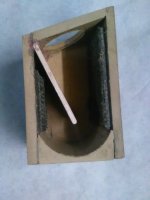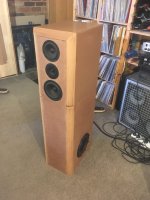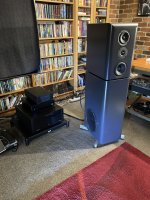In one of my projects, it would be convenient to mount the woofers on the side of the cabinet, rather than the front. However after searching the forum I've found three different opinions of what crossover point makes that arrangement acceptable. One says low enough that the radiation is 4pi, another says low enough that the woofers are located within 1/4 wavelength of the mids to produce one coherent wave, another says less than (around) 80hz where we lose the ability to judge direction/location easily.
The first two would be easy enough but 80hz is much lower than I intend, if that were necessary for seamless results then I would definitely prefer to mount the woofers on the front baffle instead. Which is possible but would make the cabinets wider than wished for their desktop near-field application. And as that implies, I'll also be listening to these at only a couple of feet distance, so slight positional differences might (in some cases) be much more apparent from close up.
Can anyone help enlighten me as to how low I might truly need to cross if wanting to safely use side-firing drivers in a near-field situation?
Thanks,
Kev
The first two would be easy enough but 80hz is much lower than I intend, if that were necessary for seamless results then I would definitely prefer to mount the woofers on the front baffle instead. Which is possible but would make the cabinets wider than wished for their desktop near-field application. And as that implies, I'll also be listening to these at only a couple of feet distance, so slight positional differences might (in some cases) be much more apparent from close up.
Can anyone help enlighten me as to how low I might truly need to cross if wanting to safely use side-firing drivers in a near-field situation?
Thanks,
Kev
Last edited:
Thanks, GM. That might be encouraging!
Scott, the crossover would be about 180hz to 200hz, the slope isn't decided yet (likely not massively critical from the driver's perspective). Which is quite low, but a long way off the 80hz I recall being mentioned for locatability (if that is a word).
The front baffle would probably be a minimum of about 8" wide (though I'm tempted to go a bit wider for even bigger roundovers for the mid driver). But should the woofers be placed on the front baffle then it would need to be at least 10" wide even without roundovers (perhaps they aren't needed for a woofer).
Scott, the crossover would be about 180hz to 200hz, the slope isn't decided yet (likely not massively critical from the driver's perspective). Which is quite low, but a long way off the 80hz I recall being mentioned for locatability (if that is a word).
The front baffle would probably be a minimum of about 8" wide (though I'm tempted to go a bit wider for even bigger roundovers for the mid driver). But should the woofers be placed on the front baffle then it would need to be at least 10" wide even without roundovers (perhaps they aren't needed for a woofer).
At 200 Hz you should be *fine, perhaps slanting the baffle for better alignment of acoustic center (moving the bass driver further forward).
*almost 6 feet for the wavelength at 200 Hz.
*almost 6 feet for the wavelength at 200 Hz.
Last edited:
You're welcome!Thanks, GM......a long way off the 80hz I recall being mentioned for locatability (if that is a word).
This dates from the earliest days of cinema sound and updated to 120 Hz with THX, Dolby where multiple subs were required, so normally not relevant for HIFI speakers.
Yes it is, even spelled right!👍; though when in doubt the WWW has a pretty good dictionary for English and a lot of its colloquialisms such as my Southern/'redneck' slang I'm notorious for.🙄
As Scott kind of implied, sound 'bubbles' expand exponentially, hence in octave spreads, so are really large down low, ergo you can mentally visualize this or draw them to scale (I use to do this primarily for rooms) per diameter = ~34400 cm (~13543")/pi/f
Fh = Fl*2^n
Fl = Fh/2^n
n = ln(Fh/Fl)/ln(2)
where:
Fh = upper frequency
Fl = lower frequency, or the XO point in this case
n = octave spread
ln(2) = 0.6931
One of the advantages of side mounting woofers is to take advantage of the opposed reaction forced cancelling of woofer induced cabinet vibration.In one of my projects, it would be convenient to mount the woofers on the side of the cabinet, rather than the front.
This really works if done properly. I now mainly use force cancelling for LF and subwoofer projects.
For a larger speaker where there is a significant physical separation between the woofer and mid range, I think the 80 Hz crossover is sensible. If the box is more compact, as for near field use, there probably won't be an audible discrepancy between the woofer position and the mid-range position. I have used 160 Hz crossover between side mounted 6" woofers and dual 4" mid-range (MTM) and it was fine. I used an active dsp crossover and the seamlessness of the crossover will depend on the accuracy of the crossover, time-alignment, eq, etc. It would be more difficult with a passive crossover.However after searching the forum I've found three different opinions of what crossover point makes that arrangement acceptable. One says low enough that the radiation is 4pi, another says low enough that the woofers are located within 1/4 wavelength of the mids to produce one coherent wave, another says less than (around) 80hz where we lose the ability to judge direction/location easily.
I built a pair of 3-way speakers with exactly the same purpose, for home studio monitoring. They were originally MTM + side mounted woofers. I focussed on making them as compact as I could get away with. They turned out to exceed my expectations to such an extent that I have since used similar strategies in much larger speakers with very good results. I am mindful of the greater importance of keeping the woofer-mid crossover frequency low for a larger speaker. To keep this around 80 Hz, pushes the mid-range driver range wider than I like. I try to keep drivers to at most a 3-octave range. This means that my larger speakers are 4-way and use a lower mid-range (80 Hz-640 Hz) with upper mid-range (640 Hz-2560 Hz). I have recently replaced one of the mid-range drivers by a 2" dome upper mid-range and converted the speaker to active 4-way dsp, which is probably overkill for the initial purpose, but they now work well in a normal domestic environment. The original MTM baffle works best if sitting directly on the tweeter axis and comb filtering is minimised by room acoustic treatment.The first two would be easy enough but 80hz is much lower than I intend, if that were necessary for seamless results then I would definitely prefer to mount the woofers on the front baffle instead. Which is possible but would make the cabinets wider than wished for their desktop near-field application. And as that implies, I'll also be listening to these at only a couple of feet distance, so slight positional differences might (in some cases) be much more apparent from close up.
Can anyone help enlighten me as to how low I might truly need to cross if wanting to safely use side-firing drivers in a near-field situation?
Thanks,
Kev
I might also mention that I give a high priority to minimising the effects of edge diffraction, hence the 1 1/2" hardwood roundovers.
Attachments
-
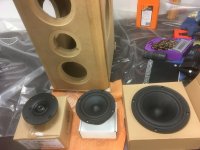 IMG_0148.JPG349.7 KB · Views: 293
IMG_0148.JPG349.7 KB · Views: 293 -
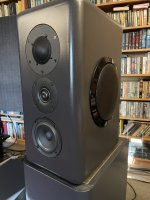 IMG_0458.jpeg465.5 KB · Views: 289
IMG_0458.jpeg465.5 KB · Views: 289 -
 53215506615__7355FDE0-1406-4DF8-A8D2-1A567AFEC7AC.JPG419.3 KB · Views: 279
53215506615__7355FDE0-1406-4DF8-A8D2-1A567AFEC7AC.JPG419.3 KB · Views: 279 -
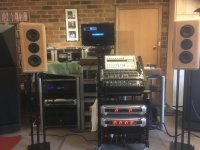 53207141751__93516AA1-3189-49B6-A0AB-26315AD93CF3.JPG416.7 KB · Views: 284
53207141751__93516AA1-3189-49B6-A0AB-26315AD93CF3.JPG416.7 KB · Views: 284 -
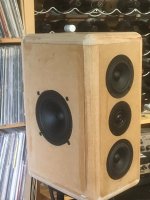 IMG_0157.JPG366.6 KB · Views: 282
IMG_0157.JPG366.6 KB · Views: 282 -
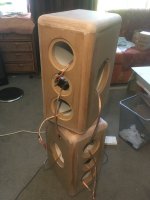 IMG_0152.JPG359.7 KB · Views: 281
IMG_0152.JPG359.7 KB · Views: 281 -
 53178546557__719B83CD-2DAF-4711-9E11-488E291A9766.JPG349.2 KB · Views: 242
53178546557__719B83CD-2DAF-4711-9E11-488E291A9766.JPG349.2 KB · Views: 242
The baffle only needs to be wide enough to fit the bass driver where the driver is located.
Thanks, yes it occurred to me (as I was writing the OP) that this might be so. Further research around the forum seems to support it, and so it is good of you to confirm it.
So in my case the difference in front baffle width need not be much more for the woofers, compared to what is already wanted for the mid+tweeter with big round-overs either side.
Though in this particular case having all the drivers on the front baffle would also make it taller, more than I'd prefer (to fit nicely either side of a monitor). So side-mounting them still has attractions and (it would seem) is perfectly acceptible.
So in my case the difference in front baffle width need not be much more for the woofers, compared to what is already wanted for the mid+tweeter with big round-overs either side.
Though in this particular case having all the drivers on the front baffle would also make it taller, more than I'd prefer (to fit nicely either side of a monitor). So side-mounting them still has attractions and (it would seem) is perfectly acceptible.
Bon, thank you for the thoughts and the detailed post! It is interesting to see that you've been down a somewhat similar path to which my thinking is taking, and great to hear that your results exceeded expectations. That must be deeply satisfying!
I'm not in need of the same SPLs that your speakers are capable of, which makes things a little easier for me. So at least to begin with I'll probably be attempting 180hz to 5khz in one wide-range driver, though that might change once I try it. If not happy then yes, I'd be quite content to add a lower-mid/upper-bass driver crossed over at 640hz, or even a bit more.
Thanks again,
Kev
I'm not in need of the same SPLs that your speakers are capable of, which makes things a little easier for me. So at least to begin with I'll probably be attempting 180hz to 5khz in one wide-range driver, though that might change once I try it. If not happy then yes, I'd be quite content to add a lower-mid/upper-bass driver crossed over at 640hz, or even a bit more.
Thanks again,
Kev
Couldn't you go half way, and have one woofer in the front, and one in the rear (at the same height)?
This way you wouldn't have the height problem, the front woofer would be aligned with the other drivers, the rear would radaite the sound as if it was coming half way between the front and back, and you get the force cancelation.
This way you wouldn't have the height problem, the front woofer would be aligned with the other drivers, the rear would radaite the sound as if it was coming half way between the front and back, and you get the force cancelation.
When two identical drivers are mounted back-to-back in a closed box, the radiation pattern is dipolar, essentially figure-of-eight, with deep nulls on the driver axis. The main lobes are at 90 degrees off axis. For side mounted drivers that is towards the front and back.
This can be an advantage for near field listening since minimal sound is directed towards the side walls to be reflected back.
With front and back mounted drivers there would be minimal sound arriving at the listening position and lobes directed towards the side walls.
This can be an advantage for near field listening since minimal sound is directed towards the side walls to be reflected back.
With front and back mounted drivers there would be minimal sound arriving at the listening position and lobes directed towards the side walls.
Last edited:
Yes, for critical near-field monitoring it makes a lot of sense to try and cover the whole mid-range with a single, very competent driver. I don't know where you would find an exceptional mid driver to cover 5 octaves. Even the ATC soft dome mid range claims 350 Hz-3.5 kHz. There is an interesting test report here:I'm not in need of the same SPLs that your speakers are capable of, which makes things a little easier for me. So at least to begin with I'll probably be attempting 180hz to 5khz in one wide-range driver
http://www.troelsgravesen.dk/ATC-SM75-150.htm
My original MTM was an attempt to keep mid-range distortion low by doubling up on the mid-drivers.
Yes, it is certainly a challenge. Though of course there are those over on the full-range forum who'll happily use one driver for the whole spectrum, so it seems these things are open to personal preference, where one wants to draw the compromises. I'm not so keen on that myself, preferring at least the woofer-assisted approach and in some cases a tweeter.
However some of the widerange drivers used are quite interesting, so I've been testing a few. There is a little 2" cone one that I could accept even without a tweeter, but IMO it is slightly too small for this project (I'd want to team it with a lower-mid driver, or an elabourate cabinet, to meet the ~180hz crossover point intended here). I've also tried a 4" cone one which is not awful but conversely is a bit bigger than I wanted for this project. They achieve higher frequency dispersion with clever cone breakup, so it is better than a standard 4" cone but still (of course) a compromise to use something bigger than needed.
So, I've ordered a pair with 3" cones, the alpair 7, which I think should be the best size compromise for the range I want to cover, and will test those to see if I like them for this application or not. It is just possible that (with my hearing) I might find them okay without a tweeter but that isn't the intention at the moment. I have a pair of 3/4" SB acoustics tweeters on hand and I don't object very much to crossing over above about 5khz, since around that point I believe we lose the ability to distinguish a lot of what makes a separate driver/source undesirable.
Thats the very early plan anyway, it could all change when I actually test the drivers.
However some of the widerange drivers used are quite interesting, so I've been testing a few. There is a little 2" cone one that I could accept even without a tweeter, but IMO it is slightly too small for this project (I'd want to team it with a lower-mid driver, or an elabourate cabinet, to meet the ~180hz crossover point intended here). I've also tried a 4" cone one which is not awful but conversely is a bit bigger than I wanted for this project. They achieve higher frequency dispersion with clever cone breakup, so it is better than a standard 4" cone but still (of course) a compromise to use something bigger than needed.
So, I've ordered a pair with 3" cones, the alpair 7, which I think should be the best size compromise for the range I want to cover, and will test those to see if I like them for this application or not. It is just possible that (with my hearing) I might find them okay without a tweeter but that isn't the intention at the moment. I have a pair of 3/4" SB acoustics tweeters on hand and I don't object very much to crossing over above about 5khz, since around that point I believe we lose the ability to distinguish a lot of what makes a separate driver/source undesirable.
Thats the very early plan anyway, it could all change when I actually test the drivers.
As a small note, I've been looking at some practicalities of the side-facing option. A couple of small disadvantages have come up; one is that the woofer magnet would block my (mild) preference to have a long/deep tapering mid-range compartment, another is that they really might not work so well where there is stuff (shelves etc) right up to each side of the desk.
By comparison having the woofer on the front would only make the speaker a tiny bit wider. It would make it about 18" (46cm) high which is a little more than wished, but acceptable. So really there are pros and cons to either arrangement, and either are possible, so it is nice to have the option.
A third promising answer would be to learn from how Bon's speakers evolved, and introduce just a small midwoofer to the front. The current big woofers could still be on the sides or more interestingly I could lower their XO frequency and use them as separate stereo subs; perhaps in a reflex cabinet. That might help quite a lot in keeping the size of the 'main' speakers suitably compact.
By comparison having the woofer on the front would only make the speaker a tiny bit wider. It would make it about 18" (46cm) high which is a little more than wished, but acceptable. So really there are pros and cons to either arrangement, and either are possible, so it is nice to have the option.
A third promising answer would be to learn from how Bon's speakers evolved, and introduce just a small midwoofer to the front. The current big woofers could still be on the sides or more interestingly I could lower their XO frequency and use them as separate stereo subs; perhaps in a reflex cabinet. That might help quite a lot in keeping the size of the 'main' speakers suitably compact.
Last edited:
As pointed out in post #13, the side mounted radiation pattern has nulls on the woofer axis, and should fire less towards the sides than traditional front mounted woofers. I do have an impression that side mounted woofers drive a room differently. However when used as near field monitors, the room acoustics have less effect on the subjective results. I do think that mixing desk clutter and nearby furniture will affect the sound, but that is true for any loudspeaker. The overall height of the speakers in post #8 is 50cm (20"). The FR is measured at 1m on axis, distance 2m from the nearest wall, where it is pretty flat down to 50 Hz. This is quite adequate for 2x6" woofers without significant boundary re-inforcement.
To show where my experiments on side mounting woofers have lead, I attach some photos of my current main speakers, which are essentially similar to the near field monitors of #8 sitting on a separate decoupled reaction cancelling subwoofer box containing 2x8" drivers.
To show where my experiments on side mounting woofers have lead, I attach some photos of my current main speakers, which are essentially similar to the near field monitors of #8 sitting on a separate decoupled reaction cancelling subwoofer box containing 2x8" drivers.
Attachments
Thanks. Yes; it would probably still work but would be affected a little bit by stuff near by. In particular, to one side is the monitor; the woofer would be largely firing behind this, as it forms almost an extension of the front baffles. On the other side are bookcases that are quite close, they might even try to slot-load the woofer slightly.
Probably the room could be re-arranged (and it likely will be in this case). But I also want to account for likely future scenarios, and I think lack of space around the desk might be quite a likely possibility. So I'll have to do some tests to see what is actually audible (to me) before I decide. I need to make some rough test cabinets anyway, and make some decisions on the smaller drivers.
I like your room speakers too. I suspect they probably involve enough SPL and cone displacement to really benefit from opposing woofers. I don't really have the room (or neighbors) to make such things sensible at the moment, but if I ever do then I can well envisage opposing woofers and/or subwoofers would be on the wish list. Though I've become interested in compression drivers and directivity so my top end might differ somewhat.
Probably the room could be re-arranged (and it likely will be in this case). But I also want to account for likely future scenarios, and I think lack of space around the desk might be quite a likely possibility. So I'll have to do some tests to see what is actually audible (to me) before I decide. I need to make some rough test cabinets anyway, and make some decisions on the smaller drivers.
I like your room speakers too. I suspect they probably involve enough SPL and cone displacement to really benefit from opposing woofers. I don't really have the room (or neighbors) to make such things sensible at the moment, but if I ever do then I can well envisage opposing woofers and/or subwoofers would be on the wish list. Though I've become interested in compression drivers and directivity so my top end might differ somewhat.
Only if connected "out of phase" (diaphragms move in the same direction, one in, one out)When two identical drivers are mounted back-to-back in a closed box, the radiation pattern is dipolar, essentially figure-of-eight, with deep nulls on the driver axis.
- Home
- Loudspeakers
- Multi-Way
- Side-firing woofers and crossover frequency in the near-field
